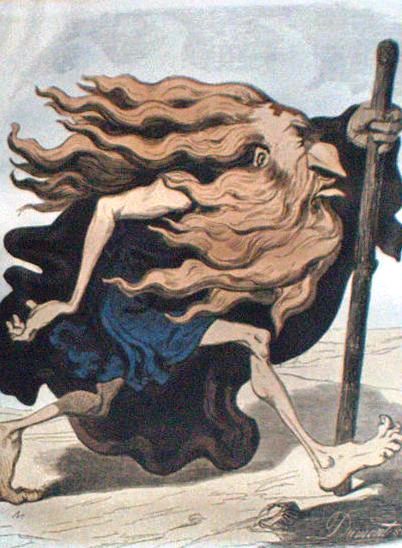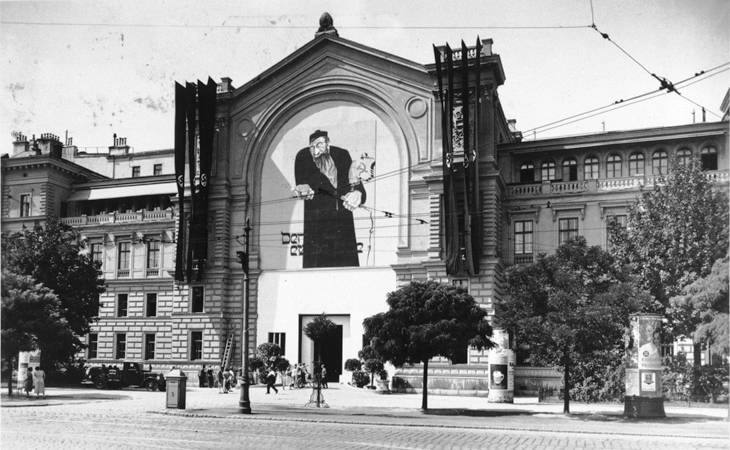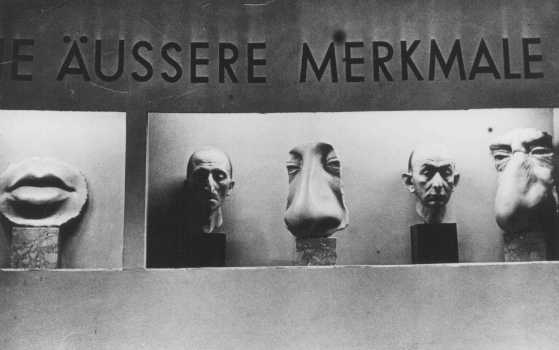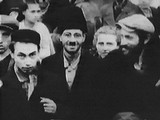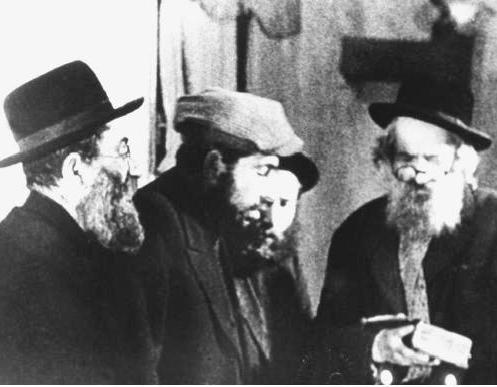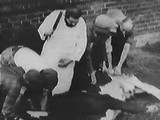Holocaust Education & Archive Research Team |
|
Holocaust Prelude Early Nazi Leaders Nazi Propaganda Nazi Racial Laws Sinti & Roma Kristallnacht The SS SS Leadership Wannsee
Prelude Articles Image Galleries | ||||||||||||||||||||||||||||
Der ewige Jude The "Eternal Jew" or the "Wandering Jew"
The concept of the "Wandering Jew" is far older than National Socialism. It derives from a literary and popular legend, about a Jew who mocked or mistreated Jesus while he was on his way to the cross and who was condemned therefore to a life of wandering on earth until Judgment Day.
The story of this wanderer was first recorded in the chronicles of Roger of Wendover and Matthew of Paris during the thirteenth century. The exact nature of the wanderer's indiscretion varies in different versions of the tale, as do aspects of his character, some of the more common themes being the doom of the "Wandering Jew" to travel the world forever, forsaken by all unfortunate enough to encounter him. The Eternal Jew exhibition first opened in the Library of the German Museum in Munich on November 8, 1937, and ended on January 31, 1938. Billed as a degenerate-art exhibition, it was the largest prewar anti-Semitic exhibit thus far produced by the Nazi's. The exhibit featured photographs pointing out the typically "Jewish" features of political figures, such as Leon Trotsky, and international film star Charlie Chaplin.
The displays emphasized supposed attempts by Jews to bolshevize Germany, It did this by revealing an 'eastern' Jew - wearing a kaftan, and holding gold coins in one hand and a whip in the other. Under his arm is a map of the world, with the imprint of the hammer and sickle. The exhibition attracted 412,300 visitors, over 5,000 per day.
The exhibition moved to Vienna for August 2 through October 23, 1938, and then to Berlin from November 12, 1938 through January 31, 1939. Police reports stated there was a direct correlation rise in anti-Semitic feelings, and in some cases violence against the Jewish community in each city the exhibition was held.
The film Der ewige Jude opened on November 29th, 1940 throughout the German Reich. Each city where the film played had it's own posters. In the Altenkirchen district of Betzdorf, the film was described as a "documentary film about world Jewry". "It is unique because it is no fantasy, but undiluted reality."
The Nazi goal of Der ewige Jude is to be the first film to portray a fully exposed picture of world Jewry, and to be a "valuable tool in the struggle to break the power of the Jews over the Aryan race."
The consistent theme throughout the film of the Jew as parasite in an otherwise healthy host, is found throughout the film in several forms, each of them designed to reveal to Germans the "true" Jew underneath the veneer of European culture that concealed the Jewish parasite.
Jews are introduced as a foreign, swarthy, hook-nosed, untidily bearded, sullen presence that clogs the teeming streets of middle Europe. They haggle, squabble over food at the table, hoard with wealth, conceal it from tax collectors, and grow sleek and fat at the expense of good Germans. Their religion and culture are seen as cabalistic sources of secret powers.
In one famous scene, swarms of rats scurry through cellars and sewers, the shots are intercut with images of Jews emigrating from Palestine to to all corners of the world. The overlaid text conveyed the message:
"Where rats turn up, they spread diseases and carry extermination into the land. They are cunning, cowardly and cruel, they travel in large packs, exactly the way the Jews infect the races of the world."
Artistically, the film is a "black masterpiece" of the cinematic conventions of 1940; a German version of The March of Time style that included animated maps, falsely labeled stock footage, segments of feature films borrowed to make some ideological point, stills, decoupages of evocative book jackets and headlines, and an omniscient voice-over narration.
The film was directed by Fritz Hippler, the Director of the Film Department of the ministry subordinate to only Joseph Goebbels, for all films produced by the Reich ministry. Born in Berlin in 1909, Hippler studied at Berlin and Heidelberg universities, completing a thesis on Marx, Mill and Lagarde for which he was awarded a doctorate of philosophy.
As a student he was already enthusiastic about the Nazis, joining their various organizations as early as 1926. They promised to create work for all, end corruption and restore Germany's place in the world, this appealed to Hippler who managed to obtain a position working on newsreels. The quality of of his work did not go un-noticed and several reels impressed Goebbels who later promoted him to Director in 1939.
Throughout the making of Der ewige Jude, Hippler kept in daily contact with Goebbels, he returned with final footage to Berlin on October 16, 1940. The rushes were developed the same day and shown to Goebbels during the evening. The pictures of half-an-hour with ritual slaughtering, deliberately staged as cruelty to animals, shocked Goebbels who wrote in his diary the next morning:
"Dieses Judentum muss vernichtet werden." (This Jewry must be annihilated).
The importance of Der ewige Jude lies not in its technique but in its brutal service to the cause of Nazi racism. Hippler's Der ewige Jude, would "fill the spectator with a feeling of deep-seated gratification for belonging to a people whose leader has absolutely solved the Jewish problem." It is believed that films such as Der ewige Jude helped prepare the German people to accept the eventual policy of genocide inflicted upon Jews.
Two different versions of the film were made, the original version, and a toned down one without the gory scenes of ritual slaughtering. In Berlin the film opened simultaneously in sixty six theaters with the two versions shown at different times of the day.
One review by the Deutsche Allgemeine Zeitung stated:
"Only when the film ends, can the viewer breathe again, from the darkest recess does he come back to the light again."
Despite such press reviews, the commercial success of Der ewige Jude paled in comparison to other anti-Semitic films such as Jud Süss. SD reports from many regions in Germany and Austria were consistent: "The horror scenes disgusted viewers and the documentary aspect was considered nerve racking."
Despite the commercial failure of the film, images were replicated onto posters and publications throughout the Reich and occupied Europe. The goal of eliciting fear, disgust and hatred, toward the Eternal Jews was summed up by one critic:
"One has a deep sense of salvation after seeing this film. We have broken their power over us. We are the initiators of the fight against world Jewry, which now directs its hate, its brutal greed and destructive will toward us. We must win this battle for ourselves, for Europe, for the world."
Hippler was captured by the British in 1944. He escaped prosecution as a criminal when Allied tribunals failed to convict other filmmakers, such as Veit Harlan,(Jud Suss). After a process of "de-Nazification" he served the American Army as a translator. In later life, he earned his living as a travel agent.
Sources: Inhaltsbeschreibung im Programmheft (Illustrierte Filmkurier No. 279/1940, November 27, 1940). Yad Vashem.
Copyright: Carmelo Lisciotto H.E.A.R.T 2008
|
